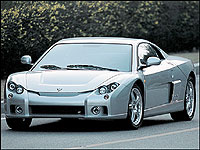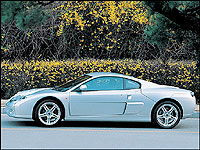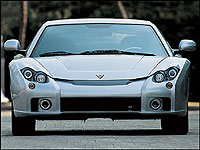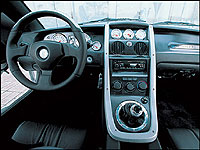
4-11-2005
by Justin Couture
Lightweight Supercar Speeds to 100 KM/H in only 4.4 Seconds
At this year's Seoul Motor Show, the main Korean players were out in full force, displaying their products for the home
 |
| Proto Motors is Korea's first supercar manufacturer. (Photo: Proto Motors) |
But out of all the carmakers present with the glitz of multi-million dollar displays and the glamor of shiny new metal, there was one tiny firm which pulled the rug out from under their feet for crowd popularity - Proto Motors, Korea's first supercar manufacturer.
The Spirra supercar is Proto's first car, and there's no better way of making a public debut than to go this route. Though new to making a car on its own, the firm is no stranger to the processes of the automotive industry. Since 1997, Proto has had several contracts with such giants as Hyundai-Kia, helping out with their electric car prototypes, and (ironically) building the displays for their international auto shows.
 |
| The Spirra 4.6 GT, the company's finished, production-ready product, is an evolution of two previous attempts. (Photo: Proto Motors) |
The Spirra 4.6 GT, the company's finished, production-ready product, is an evolution of two previous attempts. In 2002, the company previewed the PS-II, a sleek, attractive mid-engined sports car, which eventually evolved into the first-generation Spirra. The latest model is, for the most part, mechanically identical; however, there are changes throughout to improve its appearance and on-road performance.
When designing the Spirra, Proto Motors chose to model it around the typical supercar layout, a midship-mounted engine for
 |
| When designing the Spirra, Proto Motors chose to model it around the typical supercar layout, a midship-mounted engine for ideal weight distribution and a low centre of gravity. (Photo: Proto Motors) |
The body of the Spirra is lean and low, but it's also smaller than most supercars at a rather compact 169.9 inches long, 75.9 inches wide, and 45.2 inches
 |
| The body of the Spirra is lean and low, but it's also smaller than most supercars. (Photo: Proto Motors) |
The prototype models featured covered projector beam lenses which swept back, far into the front fenders. With the production model, clusters of uncovered lamps have been placed towards the nose of the car, with cornering and fog lamps located in the revised air dam. Around back, the Spirra has an odd resemblance to modern mid-engined Ferraris such as the Enzo and the F430. Round, uncovered brake lamps protrude outward, while the tail does not feature a spoiler. Instead, a venturi tunnel is used to keep the car stuck to the ground.
Entrance to the well-equipped cockpit is through a pair of butterfly doors which open up, and at an angle. Stepping over the wide
 |
| The Proto Motors' vehicle follows along the lines of most supercars, treating buyers with extensive use of exotic materials. (Photo: Proto Motors) |
The Spirra 4.6 GT features a 4.6-litre DOHC V8 that makes 320-horsepower and 315 lb-ft of torque. Does the engine sound familiar? It's the same motor used in the previous generation Ford Mustang Cobra, and is probably one of the most widely-used engines in the small-scale sports car industry. Though the Spirra is the heaviest of most of these boutique-made sports cars, at 2,403 lbs, it's also the
 |
| The Spirra 4.6 GT features a 4.6-litre DOHC V8 that makes 320-horsepower and 315 lb-ft of torque. (Photo: Proto Motors) |
Though it has yet to be announced, buyers are to be offered the choice of two lesser motors along with the aforementioned V8. The first of the alternative powerplants is a 2.0-litre turbocharged inline-four, which makes 200-horsepower and 199 lb-ft of torque. Weighing in at 2,175 lbs thusly equipped, the Spirra is capable of reaching 60 mph in just 6.3 seconds, and has a top speed of 140 mph.
Next in line is a 3.0-litre V6, which develops 182-horsepower and 199 lb-ft of torque. The V6 is a more relaxed motor, less
 |
| Proto Motors caters to its domestic market of Korea; however, the brand is eager to expand elsewhere in the world. (Photo: Proto Motors) |
Currently, Proto Motors caters to its domestic market of Korea; however, the brand is eager to expand elsewhere in the world. Prime targets include Europe, where niche, low-production sports cars are commonplace, and North America. During the design process for the Spirra, the company intended it to meet the safety laws and regulations for exportation to markets around the globe.
With North America now being a key market for brands like Noble, Morgan, Caterham, Panoz and soon, TVR, it won't be too long before Proto Motors' Spirra enters the game. The V8-powered Spirra retails in Korea for 100 million Won (equivalent to $100,000).